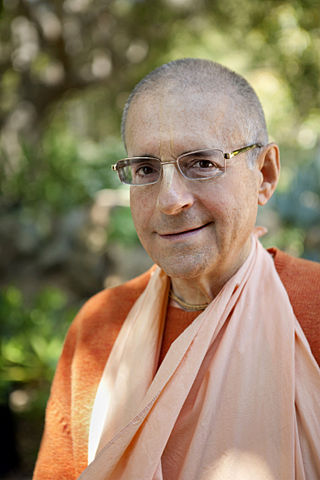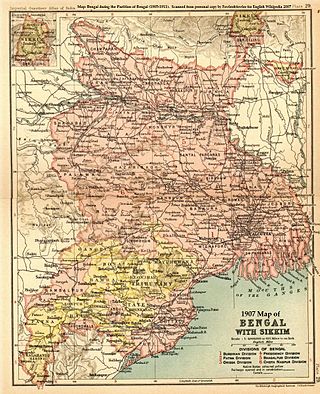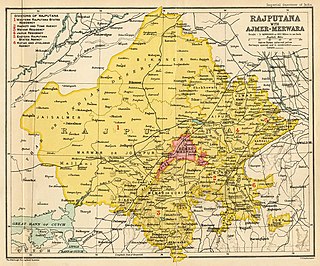| |||||
| Centuries: | |||||
|---|---|---|---|---|---|
| Decades: | |||||
| See also: | List of years in India Timeline of Indian history | ||||
Events in the year 1896 in India.
| |||||
| Centuries: | |||||
|---|---|---|---|---|---|
| Decades: | |||||
| See also: | List of years in India Timeline of Indian history | ||||
Events in the year 1896 in India.

Bhikaiji Rustom Cama or simply as, Madam Cama, was one of the prominent figures in the Indian independence movement.

The provinces of India, earlier presidencies of British India and still earlier, presidency towns, were the administrative divisions of British governance on the Indian subcontinent. Collectively, they have been called British India. In one form or another, they existed between 1612 and 1947, conventionally divided into three historical periods:

Swaminarayan, also known as Sahajanand Swami, was a yogi and ascetic, who is believed by followers to be a manifestation of Krishna, or as the highest manifestation of Purushottama, and around whom the Swaminarayan Sampradaya developed.

Giriraj Swami is an initiating guru in the International Society for Krishna Consciousness (ISKCON) and a disciple of A. C. Bhaktivedanta Swami Prabhupada, the founder-acharya of ISKCON.

The Swaminarayan Sampradaya, also known as Swaminarayan Hinduism and Swaminarayan movement, is a Hindu Vaishnava sampradaya rooted in Ramanuja's Vishishtadvaita, characterized by the worship of its charismatic founder Sahajanand Swami, better known as Swaminarayan (1781–1830), as an avatar of Krishna or as the highest manifestation of Purushottam, the supreme God. According to the tradition's lore, both the religious group and Sahajanand Swami became known as Swaminarayan after the Swaminarayan mantra, which is a compound of two Sanskrit words, swami and Narayan.

The Orissa famine of 1866 affected the east coast of India from Madras northwards, an area covering 180,000 miles and containing a population of 47,500,000; the impact of the famine, however, was greatest in the region of Orissa, now Odisha, which at that time was quite isolated from the rest of India. In Odisha, the total number who died as a result of the famine was at least a million, roughly one third of the population.

The timeline of major famines in India during British rule covers major famines on the Indian subcontinent from 1765 to 1947. The famines included here occurred both in the princely states, British India and Indian territories independent of British rule such as the Maratha Empire.

The Rajputana famine of 1869 affected an area of 296,000 square miles (770,000 km2) and a population of 44,500,000, primarily in the princely states of Rajputana, India, and the British territory of Ajmer. Other areas affected included Gujarat, the North Deccan districts, the Jubbalpore division of the Central Provinces and Berar, the Agra and Bundelkhand division of the United Provinces, and the Hissar division of the Punjab.

The Chalisa famine of 1783–1784 in the Indian subcontinent followed unusual El Niño events that began in 1780 and caused droughts throughout the region. Chalisa refers to the Vikram Samvat calendar year 1840 (1783). The famine affected many parts of North India, especially the Delhi territories, present-day Uttar Pradesh, Eastern Punjab, Rajputana, and Kashmir, then all ruled by different Indian rulers. The Chalisa was preceded by a famine in the previous year, 1782–1783, in South India, including Madras City and surrounding areas and in the extended Kingdom of Mysore.

The Doji bara famine of 1791–1792 in the Indian subcontinent was brought on by a major El Niño event lasting from 1789–1795 and producing prolonged droughts. Recorded by William Roxburgh, a surgeon with the British East India Company, in a series of pioneering meteorological observations, the El Niño event caused the failure of the South Asian monsoon for four consecutive years starting in 1789.

The Bihar famine of 1873–1874 was a famine in British India that followed a drought in the province of Bihar, the neighboring provinces of Bengal, the North-Western Provinces and Oudh. It affected an area of 140,000 square kilometres (54,000 sq mi) and a population of 21.5 million. The relief effort—organized by Sir Richard Temple, the newly appointed Lieutenant-Governor of Bengal—was one of the success stories of the famine relief in British India; there was little or no mortality during the famine.

The Great Famine of 1876–1878 was a famine in India under British Crown rule. It began in 1876 after an intense drought resulted in crop failure in the Deccan Plateau. It affected south and Southwestern India—the British-administered presidencies of Madras and Bombay, and the princely states of Mysore and Hyderabad—for a period of two years. In 1877, famine came to affect regions northward, including parts of the Central Provinces and the North-Western Provinces, and a small area in Punjab. The famine ultimately affected an area of 670,000 square kilometres (257,000 sq mi) and caused distress to a population totalling 58,500,000. The excess mortality in the famine has been estimated in a range whose low end is 5.6 million human fatalities, high end 9.6 million fatalities, and a careful modern demographic estimate 8.2 million fatalities. The famine is also known as the Southern India famine of 1876–1878 and the Madras famine of 1877. It is but one of many famines under the British rule of India.

The Indian famine of 1896–1897 was a famine that began in Bundelkhand, India, early in 1896 and spread to many parts of the country, including the United Provinces, the Central Provinces and Berar, Bihar, parts of the Bombay and Madras presidencies, and parts of the Punjab; in addition, the princely states of Rajputana, Central India Agency, and Hyderabad were affected. All in all, during the two years, the famine affected an area of 307,000 square miles (800,000 km2) and a population of 69.5 million. Although relief was offered throughout the famine-stricken regions in accordance with the Provisional Famine Code of 1883, the mortality, both from starvation and accompanying epidemics, was very high: approximately one million people are thought to have died.

The Agra famine of 1837–1838 was a famine in the newly established North-Western Provinces of Company-ruled India that affected an area of 25,000 square miles (65,000 km2) and a population of 8 million people. The central Doab in present-day Uttar Pradesh—the region of the districts of Kanpur, Etawah, Mainpuri, Agra and Kalpi—was the hardest hit; the trans-Jumna districts of Jalaun, Hamirpur, and Banda also suffered extreme distress.

The Indian famine of 1899–1900 began with the failure of the summer monsoons in 1899 over Western and Central India and, during the next year, affected an area of 476,000 square miles (1,230,000 km2) and a population of 59.5 million. The famine was acute in the Central Provinces and Berar, the Bombay Presidency, the minor province of Ajmer-Merwara, and the Hissar District of the Punjab; it also caused great distress in the princely states of the Rajputana Agency, the Central India Agency, Hyderabad and the Kathiawar Agency. In addition, small areas of the Bengal Presidency, the Madras Presidency and the North-Western Provinces were acutely afflicted by the famine.

Sri Devananda Gaudiya Math is situated at Teghori Pada in Nabadwip dham of district Nadia in the West Bengal state of India, and is a matha and prominent holy place of the Gaudiya Vaishnavas, as well the headquarters of the Sri Gaudiya Vedanta Samiti. It is located in the middle of the place earlier known as Koladvipa. The Math has been continuing as a famous religious spot thronged by thousands of devotees every year.

Sir Richard Burn was an English civil servant in British India, historian of India and numismatist. He was the editor of Volume IV of The Cambridge History of India and contributed four chapters to Volume VI of that work on the Indian political situation after 1900.
Kishorlal Ghanshyamlal Mashruwala was an Indian independence activist as well as biographer, essayist and translator. Educated in Bombay and Agra, he completed BA and LLB. He was an associate of Mahatma Gandhi and was deeply influenced by him. He extensively wrote on education, religion and philosophy as well as translated some works in Gujarati.
{{cite book}}: CS1 maint: multiple names: authors list (link)